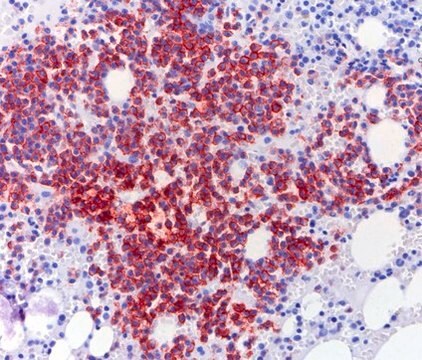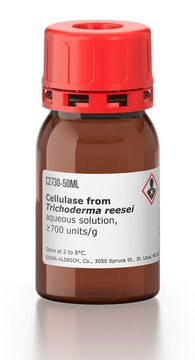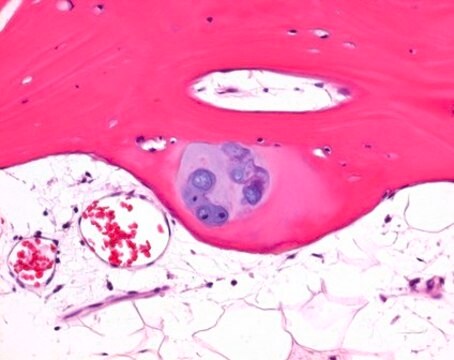D0818
Decalcifying Solution-Lite
aqueous solution, bp 208 °F
Sinônimo(s):
universal decalcifying agent
Faça loginpara ver os preços organizacionais e de contrato
About This Item
Código UNSPSC:
12171500
NACRES:
NA.47
Produtos recomendados
forma
aqueous solution
prazo de validade
5 yr
cor
light yellow
pb
208 °F
solubilidade
water: soluble
aplicação(ões)
hematology
histology
temperatura de armazenamento
room temp
Descrição geral
Decalcifying Solution-Lite is designed to be a universal and effective decalcifying agent.
Aplicação
Decalcifying Solution-Lite is intended to be used for the decalcification of routine, immunohistochemical, and bone marrow core specimens.
It works equally well with all types of samples, including calvarial bone samples in an easy-to-handle time frame.
It works equally well with all types of samples, including calvarial bone samples in an easy-to-handle time frame.
Palavra indicadora
Warning
Frases de perigo
Declarações de precaução
Classificações de perigo
Met. Corr. 1
Código de classe de armazenamento
8B - Non-combustible corrosive hazardous materials
Classe de risco de água (WGK)
WGK 3
Ponto de fulgor (°F)
Not applicable
Ponto de fulgor (°C)
Not applicable
Certificados de análise (COA)
Busque Certificados de análise (COA) digitando o Número do Lote do produto. Os números de lote e remessa podem ser encontrados no rótulo de um produto após a palavra “Lot” ou “Batch”.
Já possui este produto?
Encontre a documentação dos produtos que você adquiriu recentemente na biblioteca de documentos.
Os clientes também visualizaram
L F Machado-Silveiro et al.
International endodontic journal, 37(6), 365-369 (2004-06-10)
To measure the demineralization capability of 1 and 10% citric acid, 10% sodium citrate and 17% EDTA during immersions of 5, 10 and 15 min on root canal dentine. Crowns were sectioned from eight maxillary canines. The cementum was removed
Roger W Byard et al.
Journal of forensic sciences, 55(5), 1356-1358 (2010-05-22)
To determine whether routine decalcification may reduce the amount of stainable iron that is visible on tissue sections, samples of liver and lung tissue with excessive iron stores were placed in three standard decalcifying solutions (i) formic acid [33%], formaldehyde
P J Emans et al.
Biotechnic & histochemistry : official publication of the Biological Stain Commission, 80(3-4), 111-115 (2005-11-22)
Apoptosis is characterized by DNA strand breaks with a 3'-OH terminus, which are analyzed by terminal deoxy(d)-UTP nick end labeling (TUNEL). Proteinase K digestion is thought to be an essential step in the TUNEL procedure. The effects of decalcifying reagents
Farhana Begum et al.
Journal of neuroscience methods, 187(1), 59-66 (2010-01-02)
Histological analysis of bone encased tissue is severely hampered by technical difficulties associated with sectioning calcified tissue. Cryosectioning of bone is possible but requires significant technical adaptation and expensive materials and is often time-consuming. Some decalcifying reagents in common use
A Merchán-Pérez et al.
Histochemistry and cell biology, 112(2), 125-130 (1999-08-25)
An ascorbic acid decalcifying solution was applied to immuno- and affinohistochemical studies on the inner ear. Rat inner ears fixed in 4% paraformaldehyde in PBS or in 2% acetic acid in ethanol solutions were adequately decalcified in an ascorbic acid
Nossa equipe de cientistas tem experiência em todas as áreas de pesquisa, incluindo Life Sciences, ciência de materiais, síntese química, cromatografia, química analítica e muitas outras.
Entre em contato com a assistência técnica












